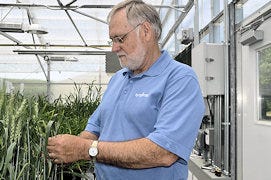
Creating hybrid wheat is simple, says Randy Rich, a veteran breeder with plenty of years invested in hybrid wheat research and the leader that Syngenta expects to bring the first commercial hybrid wheat to farm fields across the U.S. by 2020.
"Creating the hybrid is as simple as making a first cross. Breeders do it all the time in developing new varieties. The trick is finding the right production process to making those promising hybrids easy and effective to grow in commercial quantities," Rich says.

TACKLING HYBRID WHEAT: Veteran wheat breeder Randy Rich looks over a head of green wheat in the hybrid research greenhouse in Junction City, Kansas. Syngenta expects to release its first commercial hybrid wheat by 2020.
Rich joined Syngenta in 2010, joining a team that includes his son, Jon, as lead traditional wheat breeder at the station. He brought with him decades of work in hybrid wheat production, dating back to the 1970s and 1980s when he worked in the research programs for DeKalb, Monsanto and Trio.
"When Syngenta decided to come back into hybrid wheat research, I was able to come here with a pretty strong knowledge of what germplasm was already out there. It provided me a head start in getting back into research," Rich says. "We already know which lines make the best hybrids and provide that heterosis that makes hybrids perform better than either of their parents."
He says Syngenta has experienced success with hybrid barley in Europe and can build on what it has learned in that program to break the production barrier for hybrid wheat.
Rich said he thinks the target date of 2020 is achievable.
"So far, we have met every milestone we set for ourselves," he says. "We are on track."
He says he doesn't know at this time if the initial release will be a single hybrid or perhaps as many as two or three hybrids.
"Our top goal is in hard red winter wheat," he says. "However, we have all kinds of research going on in all wheat-growing regions. We are looking at spring wheats and soft wheats as well as hard red winter for possible hybrids."
However, he says, the pressure to reach higher yields in hard red winter wheat – the primary grain used for making bread – is greatest because of the demand for that crop in the human food chain.
"Hard red is where we have shortages in supply," he says. "Over the last 25 years, we have seen yields consistently increase for hybrid corn and soybeans; doubling in fact. Wheat has not even come close to seeing that kind of yield increase. We hope hybrid will be the answer to closing that gap."
Syngenta senior research fellow Rollie Sears says the qualities of the first hybrid release are already established.
"It will be a hybrid that is easy to produce reliably across many locations," Sears says. "It will offer a significant yield bump to growers and it will have good end use qualities. It will perform well across a wide variety of soil and weather conditions."
Rich says he is confident that will happen.
"We've been at this a long, long time," he says. "We know what we're looking for."
- Griekspoor writes for sister publication Kansas Farmer
About the Author(s)
You May Also Like




